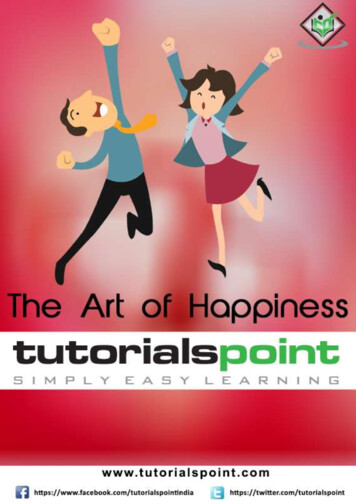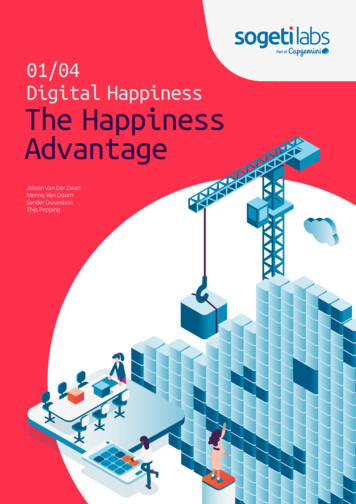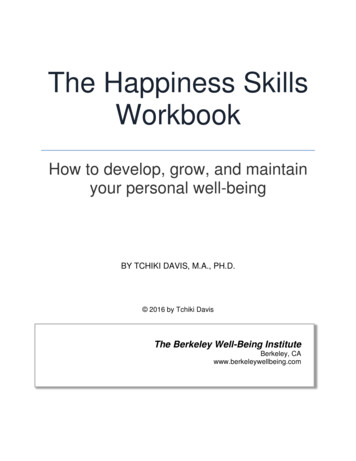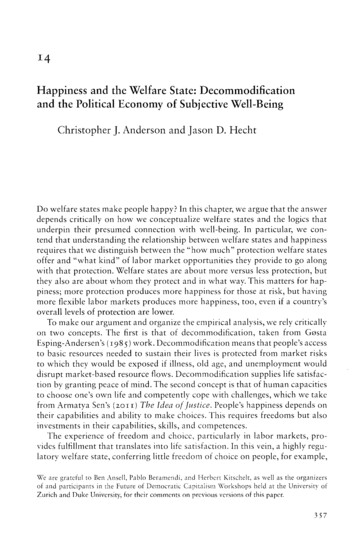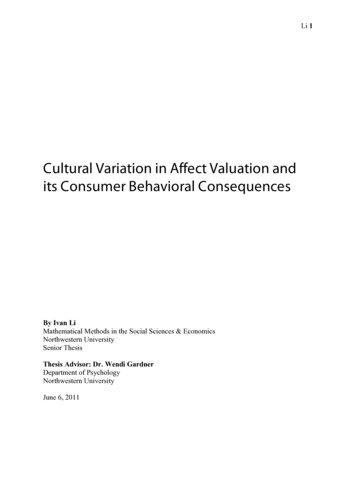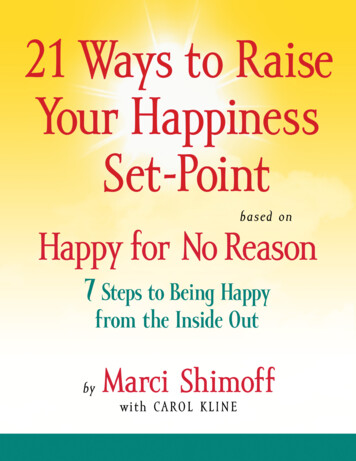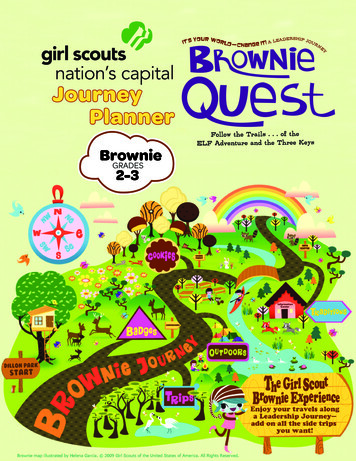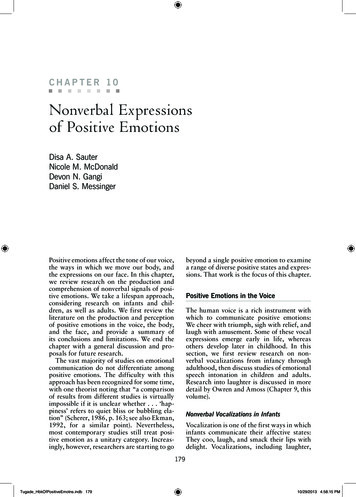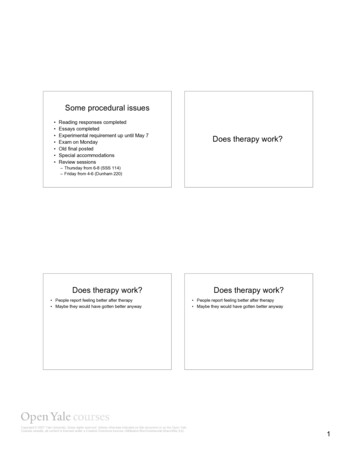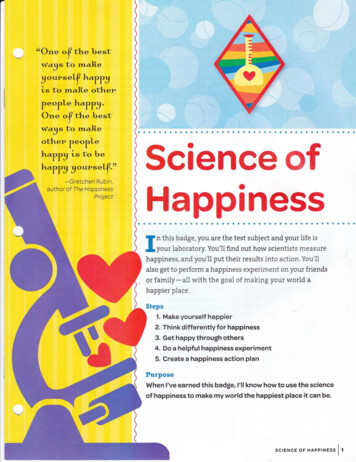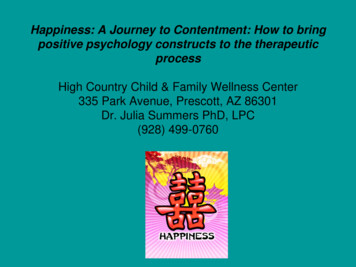
Transcription
Happiness: A Journey to Contentment: How to bringpositive psychology constructs to the therapeuticprocessHigh Country Child & Family Wellness Center335 Park Avenue, Prescott, AZ 86301Dr. Julia Summers PhD, LPC(928) 499-0760
Reflection There is almost one time that is important Now! It is the most important time becauseit is the only time when we have anypower.”-Leo Tolstoy
What is Positive Psychology? Shift in psychological approach from a disease model to focus onstrengths and not pathology” (Seligman, 2000). Development of a new branch of psychology 1999-2010 Positive psychology: started to become mainstream in 1998 byMartin Seligman. A supplement/extension of past theories. Dr. Martin Seligman Director of the Positive Psychology Center atUniversity of Pennsylvania. Beliefs of nurturing strengths, resilience, and emotional health andwhat influences positive emotions. Asking the bigger question “What makes people happy” Robert Holden PhD, The Happiness Project. Character strengths, and positive emotions. Positive Neuroscience.
Happiness/Wellbeing (Seligman Theory) Positive Emotion (What we feel, pleasure,warmth, comfort) Engagement (Flow, loss of self in anactivity) Meaning (Belonging and servingsomething that is bigger than yourself).
8 Week Happiness Course Robert Holden PhD. Happiness baseline 50/50 Summer of 1992 conducted a researchproject with Holden’s happiness course. Findings Author of “Be happy: Release the power ofhappiness in you!”
Holden’s 8 principles to being happy 1. The gift of happiness2. The happy self3. Choosing your life4. Joy unlimited5. The heart of happiness6. Everyday abundance7. Love and happiness8 Happiness now!(Holden, 2009)
Happiness GenieExercise/Results Wealth or happiness?Success or happiness?Fame or happiness?Attractiveness or happinessSex or happiness?Health or happiness?Enlightenment or happiness?Authenticity or happiness?Love or happiness?(Holden, 2009)
Happiness Paradigms Achievement paradigm (efforts, action, accomplishments). Possessions paradigm (having, getting, and external objects havinginstead of being mode). Reward paradigm (not natural needing a medal, how to feel goodenough, waiting for reward.) Destination paradigm (Searching the pursuit of happiness, future, if Iget there then I will be happy). Choice paradigm (A state of mind, cognitive, inner peace, choiceto be happy “a inside job”). Identify paradigm (A way of being, true nature, inside/outside,the soul is joy) (Holden, 2009)
What is happiness for? A Temporary escape? A Irrational responses to life? A Psychiatric disorder? Happiness is our purpose in life and we can choose tobe happy. Find our true identity by living our values. Self-realization. Who are you? Do you know who you really are? The unconditioned self, always happy
Measure your Happiness12Not true at all345Moderately true67Absolutely trueAnswer these questions and rate with the scale above.1.In most ways my life is close to my ideal.2.The conditions of my life are excellent.3.I’m satisfied with my life.4.So far I have gotten the important things I want in life.5.If I could live my life over, I would change almost nothing.Score 31-35 extremely satisfied, 26-30 Very satisfied, 21-25 slightlysatisfied, 20 neutral point, 15-19 Slightly dissatisfied, 10-14dissatisfied, 5-9 extremely dissatisfied.(Edward Diener, 1980)
When are you happy?Exercise Time How often are you very happy?List at least 5 times you were very happyDate of the last time you experienced itWhat were you doing or experiencingWhat have you learned about yourself?
Self-Acceptance You cannot find happiness you are here toextend it Self-acceptance Honest with self Improved awareness Accountability for your life
How do we limit Happiness? rol
How do we increase happiness? Treat ourselves with honesty andcompassion Even happy people are unhappy from timeto time Improve awareness of true self andacceptance of all emotions.
3 Mistakes we make with emotions Misidentification (labels) Judging self Resistance Acceptance of all feelings and emotionalinquiry. Moods come and go as if a guestin our homes. Remain neutral even giftswith uncomfortable emotions.
Interview the emotions 1. Meeting the feeling2. Naming the lesson3. Acceptance of the gift4. Ask for help“If you are alive you need help” We are notmeant to do life on our own.(Holden, 2009)
Statistics on Happiness Overall income does not determine happiness.Most individuals say they are living a good life.Family and relationships bring the most happiness.Have gratitude.Help others.Learn to forgiveTake care of your bodySavor life's joysStrategies to deal with stressors.(Wallis, 2005)
Is there a dark side to happiness? Critics of Positive Psychology constructsand research findings Balance of both happiness and sadnessand both emotions are necessary Only focus on the positive does not allowfor an environment to work through traumaand adversity.
Welcome Back
How to use Positive Psychology in theTherapeutic Process Building client rapport and relationship. Create hope and change through strengthfocused approach. Positive treatment planning Balancing both positive and negativethoughts and beliefs that contribute tooverall mental health.
The Therapeutic ProcessGoals Assist clients to identify what is working.Define strengthsExplain balance of Wellness vs. DiseaseSelf-acceptanceHow to deal with emotionsPower of positive affirmationsRestoring hope for clients.
Therapeutic Approach Strength based (Joining with the client)Identify the weaknesses/strengthsCreate a gratitude list (use during each session)Happiness Journal (To review each session)Brainstorm goals & objectives for the treatmentplan using positive psychology concepts Encouragement, optimistic, empowering, andgrowth potential.
Happiness Strategies to Teach Clients Life’s simple pleasuresFriendshipsSelf-talkPersonal resilienceActs of kindnessGratitudeSense of humorStrengths
Strength-Based Treatment Planning Define client strengths.Define specific measureable goals.Define specific steps to achieve each goal.Combine positive psychology conceptsand testing measures into strategies forsuccess. Monitor progress 1-10 scale to determineprogress and modifications to goals asneeded.
Positive Psychology Tests &Assessments Action Inventory of character strengths.Clifton strength-finderPositive-negative affect scheduleSatisfaction life scale
Four-Front Assessment Approach 1. Define areas of weakness 2. Define areas of strengths 3. Define and rate deficits regarding theenvironment of client 4. Define and rate positives in the clientsenvironment (Magyar-Moe, 2009).
Treatment Plan Example Define Problem: Depression Goal: Reduce depression Action Plan: Review gratitude list daily and combine withexercise for 30 minutes. Evaluate Progress: Beginning each session reviewstrengths, action plan and how client is progressing. Ifprogress made continue action plan. If not makingprogress, need to redefine strengths and createalternative plan. Balance both positive and negativebehaviors that may be impacting success. Praise client for progress and motivation for change.
Lets Review What is Positive Psychology? How can we implement into thetherapeutic process? How do we use positive psychology todevelop treatment plans? Can Positive Psychology assist cliniciansin positive health and wellness? Can we really choose to be happy?
Happiness Everyone can choose to be happy The power and impact of thoughts andperceptions Focus on strengths and wanting what youhave. Improve your workplace wellness andprovide a balanced approach with clients.
Websites for additional information w.psychcentral.comwww.pewresearch.org
Reflection For every minute you areangry you lose sixty secondsof happiness.”Ralph Waldo Emerson
References Goodtherapy.org. (2009). Positive Psychology: Dismissing the dark side? Holden, Robert. (2009). Be happy: Release the power of happiness in you. NewYork: Hay House. Littral, J.M. (1998). Brief counseling in action. New York: Norton Seligman, M.E, Steen TA, Park N, Peterson, C. (2005) Positive psychologyprogress: Empirical validation of interventions”. Am Psychol 60 (5): 410-21.DOI:10.1037/0003-066X.60.5.410.PMID 10. Seligman, Martin E. P.; Mihaly Csikszentmihalyi, Positive psychology: Anintroduction. American Psychologist, Vol 55(1), Jan 2000, 5-14. doi.Smith, Richard H.; Diener, Edward; Wedell, Douglas H. Intrapersonal and socialcomparison determinants of happiness: A range-frequency analysisJournal of Personality and Social Psychology, Vol 56(3), Mar 1989, 317-325. doi:10.1037/0022-3514.56.3.317
References Csikszentmihalyi, M. (1990). Flow: The psychology of optimal experience.HarperCollins Publishers.Diener, E. Fujita & Suh (1996). “Events and subjective wellbeing: Only recentevents matter”. Journal of personality and social psychology 70 (5): psycnet.apa.org/journals/psp/70/5/1091/. Haidt, Jonathan (2005) The happiness hypothesis. New York: Basic Books. Robbins, B.D. (2008). What is the good life? Positive psychology and therenaissance of humanistic psychology. The humanistic psychologist, 36 (2), 96112. Seligman, M. (1990). Learned optimism. How to change your mind and your life.Free Press. Seligman, M. (2004). Can happiness be taught? Daedalus Journal, Spring 2004.
ReferencesAdam K. Anderson, Ph.D., Associate Professor, Canada Research Chair inAffective Neuroscience, Department of Psychology, University of TorontoClifton, D. (1924-2003) Developer of the Clifton strength finder.Diener, E. (1980) Measuring your happiness scale.Park, Peterson & Seligman. (2006). Character strengths in fifty-four nations and thefifty US states. The Journal of Positive Psychology. 1(3), 118-129.Rubin, G. (2009) The happiness Project. New York: Harper.Rudin, M. (2006). The science of happiness the happiness formula.Seligman, M. (2011). Flourish. New York; Simon & Schuster.Magyar-Moe, J. (2009) Therapist guide to positive psychological interventions.Academic Press.Wallis, C. (2005). The new science of happiness. Time Magazine (January 17).Waltson, D., Clark, L.A, & Tellegen, A. (1988). Development and validation of brief measures ofpositive and negative affect: The PANAS scales. Journal of personality and socialpsychology.47, 1063-1070.
Haidt, Jonathan (2005) The happiness hypothesis. New York: Basic Books. Robbins, B.D. (2008). What is the good life? Positive psychology and the renaissance of humanistic psychology. The humanistic psychologist, 36 (2), 96-112. Seligman, M. (1990). Learned optimism. How to change your mind and your life. Free Press. Seligman, M .
